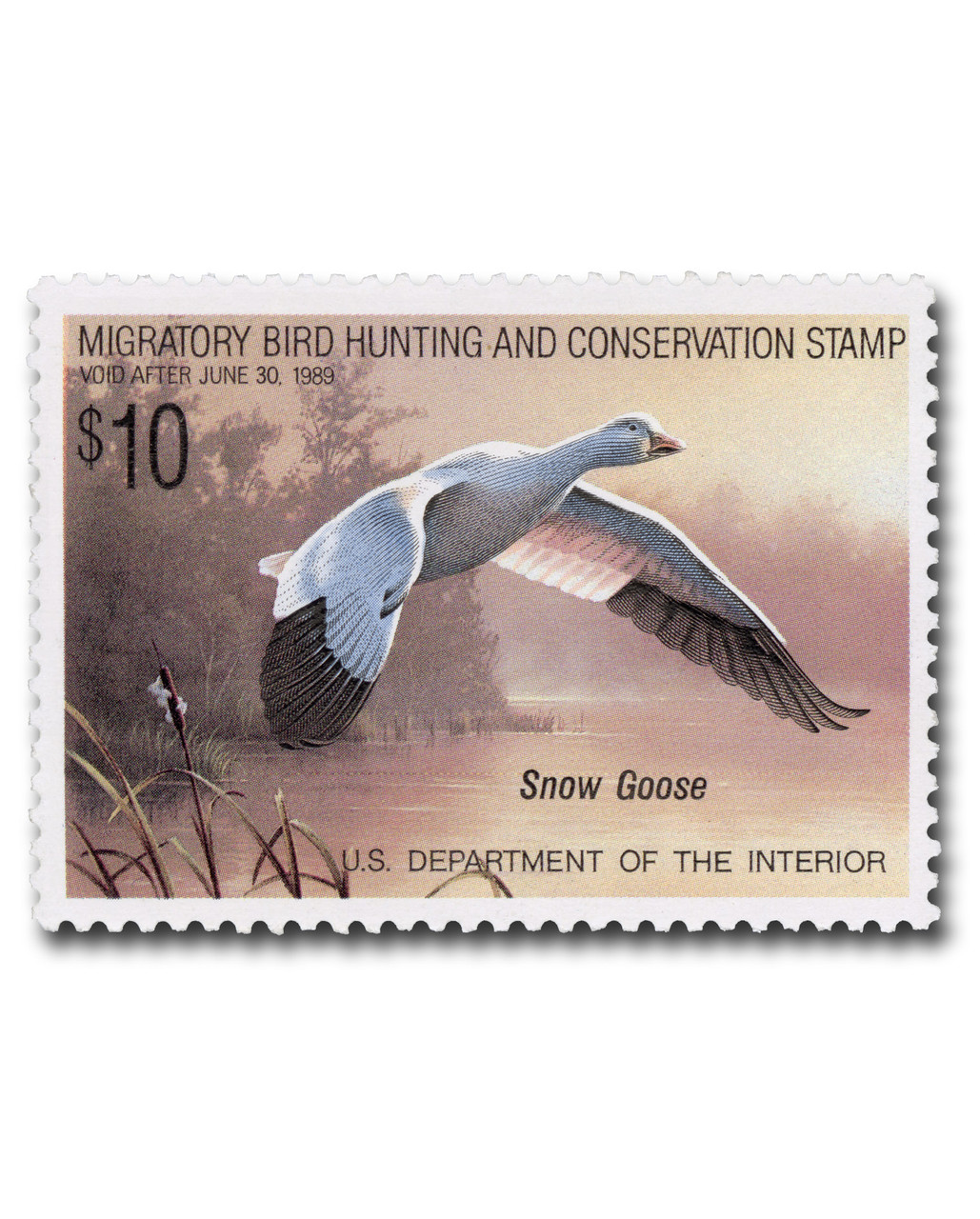
RW#55
1988 $10 Snow Goose
Issued: July 3, 1988
Quantity: 1,394,923
Artist: Daniel Smith
Perhaps no stamps are as beautiful or as popular as the Hunting Permit Stamps, better known as the “Duck Stamps.” In March 1934, Congress authorized the Postal Department to issue receipts, in the form of attractive stamps, to licensed hunters. The profits from these stamps would then go to maintaining waterfowl life in the United States. J.N. Darling, a well-known cartoonist and artist, designed the first “duck” stamp - a $1.00 issue that pictured two mallards preparing to land. Its beauty and novelty immediately appealed to stamp collectors, and the desire to own one became widespread.
The government was adamant, however. The stamp was for hunters only, not for collectors. It had to be attached to a license, and the hunter had to keep it intact for one year. But the collectors would not give up, and fifteen days before the first stamps expired they were placed on sale for stamp enthusiasts.
Issued annually, the “duck” stamps are designed by some of America's finest artists. Initially, the artwork for these stamps was commissioned, but that changed in 1949 when designer Bob Hines (creator of the 1946-47 issue) suggested the idea for a contest. Today, well-known painters and designers from throughout the U.S. compete to have their work displayed on the desirable hunting permit stamps. In 1991, Nancy Howe became the first woman to win the annual competition.
These handsome stamps have featured a wide array of waterfowl, such as Emperor Geese, Wood Ducks, Canvasback Drakes, and Whistling Swans, to name a few. All issues are inscribed “Migratory Bird Hunting Stamp.” The first five read “Department of Agriculture,” while all following issues read “Department of the Interior.” From 1946 on, all stamps bear an inscription on the back that says: “It is unlawful to hunt waterfowl unless you sign your name in ink on the face of this stamp.”
Today, this revenue program raises approximately $20 million annually, and almost four million acres of wetlands have been purchased with these funds. Not only do these stamps bring beauty to your collection, but their purchase helps protect our nation’s waterfowl.
RW#55
1988 $10 Snow Goose
Issued: July 3, 1988
Quantity: 1,394,923
Artist: Daniel Smith
Perhaps no stamps are as beautiful or as popular as the Hunting Permit Stamps, better known as the “Duck Stamps.” In March 1934, Congress authorized the Postal Department to issue receipts, in the form of attractive stamps, to licensed hunters. The profits from these stamps would then go to maintaining waterfowl life in the United States. J.N. Darling, a well-known cartoonist and artist, designed the first “duck” stamp - a $1.00 issue that pictured two mallards preparing to land. Its beauty and novelty immediately appealed to stamp collectors, and the desire to own one became widespread.
The government was adamant, however. The stamp was for hunters only, not for collectors. It had to be attached to a license, and the hunter had to keep it intact for one year. But the collectors would not give up, and fifteen days before the first stamps expired they were placed on sale for stamp enthusiasts.
Issued annually, the “duck” stamps are designed by some of America's finest artists. Initially, the artwork for these stamps was commissioned, but that changed in 1949 when designer Bob Hines (creator of the 1946-47 issue) suggested the idea for a contest. Today, well-known painters and designers from throughout the U.S. compete to have their work displayed on the desirable hunting permit stamps. In 1991, Nancy Howe became the first woman to win the annual competition.
These handsome stamps have featured a wide array of waterfowl, such as Emperor Geese, Wood Ducks, Canvasback Drakes, and Whistling Swans, to name a few. All issues are inscribed “Migratory Bird Hunting Stamp.” The first five read “Department of Agriculture,” while all following issues read “Department of the Interior.” From 1946 on, all stamps bear an inscription on the back that says: “It is unlawful to hunt waterfowl unless you sign your name in ink on the face of this stamp.”
Today, this revenue program raises approximately $20 million annually, and almost four million acres of wetlands have been purchased with these funds. Not only do these stamps bring beauty to your collection, but their purchase helps protect our nation’s waterfowl.













